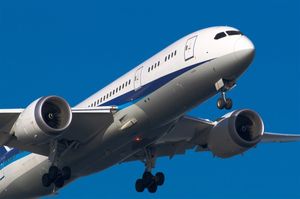
Globalstar (NASDAQ: GSAT) stock has experienced a significant surge, captivating the financial markets as whispers of a potential $10 billion sale of the satellite communications firm gain traction. The speculation, which intensified on October 23, 2025, follows reports that Globalstar's chairman, James Monroe, has been actively discussing such a possibility with associates, sending a ripple of excitement and uncertainty through the investment community. This rumored valuation represents a substantial premium over the company's current market capitalization of approximately $5.3 billion, immediately more than doubling its perceived worth.
The immediate implications for Globalstar and its investors are profound. For the company, a sale at this price point would signify a monumental strategic shift, potentially altering its long-standing relationship with key partner Apple (NASDAQ: AAPL), which has invested heavily in Globalstar's satellite connectivity for iPhone emergency services. For investors, the news has injected considerable volatility and opportunity. Shares have already seen impressive gains, up 48% in the last 30 days and 148% annually as of mid-October, with the latest rumors adding an 8% jump on the day they surfaced. While the prospect of such a lucrative sale is enticing, it also introduces a layer of speculative risk, as the deal's materialization and final terms remain unconfirmed.
The Anatomy of a $10 Billion Speculation: A Deep Dive into Globalstar's Potential Sale
The genesis of the $10 billion sale speculation on October 23, 2025, can be traced to a report by The Information, which indicated that James Monroe, Globalstar's influential chairman and a significant 59% shareholder, had engaged in discussions with associates regarding a potential sale of the company at this remarkable valuation. This figure represents a premium of nearly double Globalstar's current market capitalization, underscoring the perceived strategic value of its assets, particularly its coveted spectrum holdings.
This latest development is not an isolated incident but rather the culmination of a series of strategic maneuvers and partnerships that have positioned Globalstar at the forefront of the burgeoning satellite communications sector. A pivotal moment occurred on September 7, 2022, when Globalstar and Apple unveiled their groundbreaking agreement for satellite connectivity services for iPhones, a deal described as "transformational." Apple committed substantial capital, funding 95% of the capital expenditures for 17 new Globalstar satellites and covering associated loan interest, effectively making it Globalstar's most crucial customer with an investment nearing $2 billion over three years. More recently, Globalstar strategically moved its listing from the NYSE American to the Nasdaq Global Select Market (NASDAQ: GSAT) in February 2025, following a reverse stock split, aiming to attract a broader investor base. Just days before the sale rumors, on October 21, 2025, Globalstar commercially launched its RM200M two-way satellite IoT module, signaling an expansion into the Internet of Things (IoT) market.
Key players in this unfolding narrative extend beyond Monroe and Apple. SpaceX (NASDAQ: TSLA), led by Elon Musk, looms large as both a potential competitor and partner. Reports suggest SpaceX has updated its satellite designs to support the same radio spectrum used by Apple's iPhone satellite features, potentially enabling Starlink to offer similar services to existing Apple devices. SpaceX's acquisition of EchoStar's (NASDAQ: SATS) spectrum further solidifies its direct-to-cell ambitions. Globalstar's management team, including CEO Paul E. Jacobs, alongside institutional investors like The Vanguard Group, BlackRock, Inc. (NYSE: BLK), and State Street Global Advisors, Inc., are also significant stakeholders. Any major transaction would also necessitate the scrutiny and approval of regulatory bodies such as the Federal Communications Commission (FCC).
The immediate market reaction to the $10 billion sale rumors was unequivocally positive, with Globalstar's stock surging approximately 8% on October 23, 2025. This sharp uptick reflects investor enthusiasm for a potential deal that would unlock significant shareholder value. Industry analysts had already shown increasing confidence in Globalstar's long-term outlook, with price targets recently raised, further bolstering the positive sentiment surrounding the company. The industry is now keenly observing the competitive dynamics, particularly how SpaceX's advancements might influence future collaborations and the overall landscape of satellite connectivity services.
Shifting Tides: Who Wins and Loses in a Globalstar Acquisition Scenario?
A potential $10 billion acquisition of Globalstar would send significant ripples through the satellite communications and mobile technology sectors, creating clear winners and losers. At the forefront of the beneficiaries would undoubtedly be Globalstar itself, with its shareholders poised for a substantial return, given the rumored sale price represents a significant premium over its current market valuation. The acquiring entity, though currently unknown, would instantly gain a valuable low-Earth orbit (LEO) satellite constellation, crucial licensed L and S-band spectrum (including Band 53 and its 5G variant, n53), a burgeoning satellite IoT business, and the critical partnership with Apple. This would immediately bolster its standing in the rapidly evolving D2D and satellite IoT markets, offering synergistic benefits.
Apple, Globalstar's primary customer and a major investor, stands to gain greater independence or control over its satellite services for iPhones. Depending on the acquirer, Apple could solidify its access to Globalstar's network or renegotiate terms more favorable to its long-term strategy, potentially expanding D2D capabilities beyond emergency SOS to include broader consumer messaging or even voice services. Apple's substantial investment in Globalstar's network expansion, including its third-generation C-3 satellite system, underscores its vested interest. Furthermore, companies within Globalstar's satellite IoT ecosystem, such as Spotter International, Lasso Technologies, LLC, TGI Connect, and Conekt.ai, which leverage Globalstar's recently launched RM200M two-way satellite IoT module, would likely benefit from increased stability, investment, and potentially expanded market reach under new, well-resourced ownership. Launch providers like SpaceX, which is slated to deploy Globalstar's replacement satellites in late 2025 and 2026, would also benefit from a potentially accelerated and well-funded launch schedule.
However, a strengthened Globalstar could intensify competition for several established and emerging players. Direct competitors in the satellite communications space, such as Iridium Communications Inc. (NASDAQ: IRDM), Viasat, Inc. (NASDAQ: VSAT), and Orbcomm, which also operate in the satellite IoT market, could face heightened pressure. A more robust Globalstar, particularly one focused on affordability with its RM200M module, might trigger price competition across the sector, compelling rivals to accelerate their own technological advancements. Similarly, emerging direct-to-device (D2D) competitors like AST SpaceMobile and Lynk Global, which are actively pursuing satellite-to-phone services, could find their market entry and growth trajectories challenged by a well-capitalized Globalstar, especially if the new owner aggressively expands its D2D offerings. SpaceX's Starlink, a major D2D player with its T-Mobile (NASDAQ: TMUS) partnership, is already adapting its designs to support Apple's spectrum, indicating an escalating competitive landscape.
Mobile Network Operators (MNOs) could also see their influence diminish. Apple's existing deal with Globalstar already lessens the incentive for MNOs to forge their own satellite partnerships for ubiquitous connectivity. If a Globalstar sale strengthens and expands Apple's satellite capabilities, it could further compel MNOs to invest more aggressively in their own D2D alliances (e.g., T-Mobile with Starlink, AT&T (NYSE: T) and Verizon (NYSE: VZ) with AST SpaceMobile) to avoid being marginalized in remote coverage areas. The broader satellite service provider landscape, including companies like EchoStar Corp. and Telesat, might also feel the ripple effects of increased consolidation. A major acquisition like Globalstar could signal further industry consolidation, potentially making it harder for smaller players to compete on scale or integrated features without significant investment or strategic alliances, though it could also attract more capital to the sector overall.
A Glimpse into the Future: Wider Significance of Globalstar's Potential Deal
The rumored $10 billion sale of Globalstar, if it materializes, would be more than just a corporate transaction; it would be a bellwether for the rapidly evolving satellite communications and mobile technology industries. This valuation, nearly doubling Globalstar's current market capitalization, underscores the immense strategic value now placed on companies at the forefront of direct-to-device (D2D) satellite connectivity, spectrum holdings, and robust satellite infrastructure. The event aligns perfectly with several overarching industry trends dominating late 2025.
Foremost among these trends is the explosive growth of D2D connectivity, which is quickly moving from concept to commercial reality. With projections of up to 130 million D2D users by 2032, the ability to integrate satellite services directly into standard smartphones and IoT devices, providing messaging and emergency services in unserved areas, is considered the "next great holy grail" for satellite operators. Globalstar, with its established Apple partnership for Emergency SOS via Satellite, is a critical player in this race. The potential sale also highlights the intensifying competition within the LEO satellite constellation sector, where giants like SpaceX's Starlink, AST SpaceMobile, Iridium Communications Inc., and Amazon's Project Kuiper are vying for dominance. Furthermore, the deal emphasizes the increasing strategic importance of valuable spectrum (Globalstar holds L-band and S-band) and the ongoing industry trend of consolidation, driven by the need for scale, operational synergies, and multi-orbit capabilities to compete effectively. Recent mega-mergers like Viasat and Inmarsat, and Eutelsat Communications S.A. (EPA: ETL) and OneWeb, serve as clear precedents for this drive towards consolidation.
The ripple effects of such a sale would extend broadly across the industry. For Apple, a significant investor with a 20% stake, a change in Globalstar's ownership could necessitate renegotiation of terms for its satellite services, potentially impacting its long-term D2D strategy. Depending on the acquirer, Apple might seek to secure greater control or even consider a larger stake to ensure dedicated network capacity. For competitors like Starlink, which is aggressively expanding its Direct-to-Cell services with partners like T-Mobile, AT&T, and Verizon, a newly empowered Globalstar under deep-pocketed ownership could create a formidable rival, potentially accelerating Starlink's own D2D innovations. Similarly, AST SpaceMobile and Iridium, both actively deploying D2D solutions, could face increased pressure, possibly leading to more M&A activity within their segment as they seek strategic partnerships or scale. Smaller satellite operators like Lynk Global and Amazon's Project Kuiper might also be spurred to seek alliances to avoid marginalization in a rapidly consolidating market.
Regulatory bodies, particularly the Federal Communications Commission (FCC) in the U.S. and international telecommunication unions, would play a critical role. Any acquisition would undergo intense scrutiny regarding spectrum control and anti-trust concerns, especially if the buyer already holds significant market power. National security implications could also arise if a foreign entity were the acquirer, triggering reviews by committees like the Committee on Foreign Investment in the United States (CFIUS). Furthermore, navigating complex regulatory frameworks for interference mitigation, especially with the FCC's recent approvals for "supplemental coverage from space," would be paramount for a new owner planning expanded services. The deal could also influence the direction of D2D standardization, either by promoting proprietary technologies or accelerating the adoption of common 3GPP standards. Historically, the telecom and satellite sectors have seen transformative deals driven by technological shifts and market demands, and a $10 billion Globalstar sale would firmly place itself among these pivotal moments, signaling a new era for satellite-enabled mobile connectivity.
The Road Ahead: Navigating Globalstar's Future Amidst Speculation
The swirling rumors of a potential $10 billion sale for Globalstar place the company at a pivotal juncture, promising a future that could either see it integrated into a larger entity or continue its independent trajectory with renewed focus. As of October 23, 2025, both short-term and long-term possibilities for Globalstar and the broader satellite communications industry are being keenly assessed, with strategic pivots, emerging market opportunities, and formidable challenges defining the landscape.
In the short term (the next 12-24 months), if the sale materializes, Globalstar would undergo integration with its acquirer, leading to potential shifts in operations, management, and resource allocation. Should the sale fall through, Globalstar is poised to continue executing its current strategic plan, which includes significant infrastructure upgrades and product rollouts. The company has reaffirmed its 2025 revenue outlook of $260-$285 million, with adjusted EBITDA margins around 50%. Key short-term drivers include the recent commercial launch of its two-way RM200M satellite IoT module, designed to penetrate diverse enterprise verticals for real-time asset tracking and control. Furthermore, Globalstar is actively advancing its C-3 Extended MSS Network, with initial replacement satellites slated for launch in late 2025 via SpaceX, enhancing network capacity and resiliency. Its global ground infrastructure program is also expanding, with approximately 90 antennas across 35 ground stations in 25 countries.
Looking further out (beyond 24 months), Globalstar's long-term vision includes more than doubling its revenue to over $495 million, with adjusted EBITDA margins exceeding 54% once its Extended MSS Network service is fully operational. This growth is underpinned by several strategic pillars: the XCOM RAN platform, targeting terrestrial wireless markets with high-performance 5G architecture for industrial applications; the continued deployment of its third-generation C-3 system with SpaceX into 2026; and an exclusive partnership with Parsons (NYSE: PSN) for public sector and defense applications, a significant growth area amidst rising defense budgets. Crucially, its enduring partnership with Apple for Emergency SOS via Satellite, which allocates 85% of its network capacity and extends until at least 2029, remains a cornerstone of its long-term financial stability.
Strategic pivots would be inevitable in either scenario. If the sale materializes, the acquiring company would integrate Globalstar's LEO constellation, terrestrial spectrum (Band n53), and ground infrastructure, potentially unlocking new synergies and market reach. This could also prompt Apple to diversify its satellite partners or accelerate its own satellite ventures, especially given SpaceX's alignment of new satellite designs to support iPhone satellite features. If the sale does not occur, Globalstar would need to intensify its self-funded growth, deepen existing partnerships, aggressively expand market adoption for its IoT and XCOM RAN solutions, and maximize the monetization of its Band n53 terrestrial spectrum through hybrid satellite-terrestrial services.
Market opportunities are abundant, particularly in the rapidly expanding Direct-to-Device (D2D) connectivity and satellite IoT segments, projected to reach 130 million users and a $2.4 billion total addressable market, respectively, by 2032. Globalstar's two-way RM200M module positions it strongly to capitalize on these trends. The integration of satellite technology into the 5G ecosystem (5G NTN) and increasing demand from government and defense sectors also present significant growth avenues. However, formidable challenges persist, including intensifying competition from major LEO players like SpaceX's Starlink and Amazon's Kuiper Systems, high capital expenditure requirements, the need for continuous technological advancements (e.g., laser communications, AI), and a complex regulatory environment. Regardless of the sale's outcome, Globalstar is poised for transformative growth, driven by D2D connectivity, expanding LEO constellations, and the integration of satellite services with terrestrial networks.
Conclusion: A Satellite Star in the Making
The whispers of a $10 billion sale have cast Globalstar into the financial spotlight, underscoring its pivotal role in the burgeoning satellite communications landscape. As of October 23, 2025, the key takeaway is the immense strategic value placed on Globalstar's assets—its LEO constellation, valuable spectrum, and critical partnership with Apple—all contributing to its potential as a leader in the direct-to-device (D2D) and satellite Internet of Things (IoT) markets.
Moving forward, the market is poised for continued dynamism, driven by the relentless pursuit of ubiquitous connectivity and the integration of satellite services into everyday mobile technology. While Globalstar's current valuation, with a price-to-sales (P/S) ratio of 19.6x, suggests a premium, it reflects strong investor optimism about its growth trajectory, particularly following the launch of its two-way RM200M IoT module and aggressive infrastructure investments. Analysts have raised price targets, anticipating significant long-term revenue growth and improved EBITDA margins.
The lasting impact of this event, whether through an acquisition or continued independent growth, will likely be seen in the accelerated evolution of satellite technology's integration into consumer and enterprise solutions. Globalstar's innovations are positioned to set new benchmarks for global connectivity and remote asset management.
Investors in the coming months should closely monitor several factors:
- Sale Confirmation and Details: Any official announcement regarding the rumored $10 billion sale will be the most immediate market mover.
- Apple and SpaceX Dynamics: Observe any shifts in Apple's satellite strategy or further developments from SpaceX concerning its D2D capabilities for iPhones.
- C-3 System and Ground Infrastructure Progress: Track the timely execution of Globalstar's $1.5 billion C-3 system investment and ground station expansion.
- RM200M Adoption and Revenue Generation: Evaluate the market uptake and financial contributions of the newly launched two-way satellite IoT module.
- Financial Performance Against Guidance: Scrutinize Globalstar's upcoming earnings reports against its reiterated 2025 revenue and EBITDA guidance.
- Government and Defense Contract Growth: Watch for further announcements and revenue impacts from its partnerships in the public sector.
- Valuation Sustainability: Assess whether Globalstar's growth trajectory continues to justify its premium valuation.
- Competitor Developments: Keep an eye on advancements from key competitors like Iridium Communications (NASDAQ: IRDM) and emerging D2D players.
This content is intended for informational purposes only and is not financial advice






